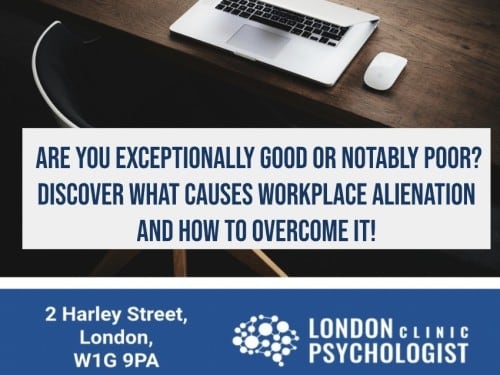Workplace Alienation

posted 19th November 2024

Understanding Workplace Alienation, Burnout, and Stress in High-Level Roles
High-level executives and professionals often seem to embody success, resilience, and control. Yet, beneath this exterior lies an increasingly common and deeply concerning issue: workplace alienation, burnout, and chronic stress. These challenges, often dismissed or overlooked, can significantly impact mental and physical health, leading to serious consequences for both individuals and the organisations they lead.
Workplace alienation can stem from a variety of factors, but extremes in job performance—being either exceptionally good or notably poor—can be significant contributors. Employees who excel at their roles may face alienation due to envy or resentment from colleagues, or because their exceptional performance sets them apart, leading to feelings of isolation. They may also be overloaded with responsibilities as a result of their competence, which can lead to burnout and a sense of being undervalued. On the other hand, employees who struggle with their tasks might experience alienation due to feelings of inadequacy, criticism from peers or supervisors, or a lack of support to improve their skills. Both scenarios highlight the importance of balanced workplace dynamics, where recognition, support, and collaboration foster inclusivity and mitigate the risk of alienation at either end of the performance spectrum.
Workplace burnout is no longer just a buzzword; it is a recognised syndrome by the World Health Organization (WHO), stemming from chronic workplace stress that has not been successfully managed. Research highlights the alarming prevalence of stress in high-level roles. A 2021 Gallup study found that 76% of senior leaders experience work-related stress daily, while a 2022 Deloitte survey revealed that 70% of C-suite executives have considered leaving their jobs due to overwhelming demands. Prolonged exposure to these pressures can lead to burnout, characterised by emotional exhaustion, detachment from work, and reduced performance. In severe cases, it can also result in physical health issues such as cardiovascular problems, as identified in studies published by the Journal of the American Heart Association.
One of the most insidious aspects of burnout in leadership is "decision fatigue." Leaders in high-pressure roles are required to make countless critical decisions daily, a mental load that drains their cognitive resources and compounds stress. Beyond the mental toll, leaders are often emotionally isolated, juggling the responsibility of guiding others while lacking the space to process their own struggles. This dynamic creates a fertile ground for alienation and feelings of detachment from both work and personal values.
Recognising the early warning signs of burnout is crucial for prevention. Emotional exhaustion, chronic fatigue, and persistent physical symptoms like headaches or digestive issues often signal that a leader is under unsustainable pressure. Additionally, detachment, cynicism, and a decline in performance may indicate that stress has escalated into burnout. These signs should not be ignored, as they are precursors to more severe psychological and physical health consequences.
Burnout does not discriminate. Even individuals at the peak of their careers have publicly acknowledged their struggles with stress and exhaustion. Ariana Huffington, founder of The Huffington Post, collapsed from burnout in 2007, prompting her to reevaluate her lifestyle and advocate for workplace wellness. Similarly, Prince Harry and Meghan Markle have spoken openly about the toll of high-pressure roles, underscoring the need to address mental health in leadership. These high-profile cases serve as reminders that success does not equate to immunity from stress.
While the problem is significant, there are effective strategies for coping with burnout and stress. Emotional resilience can be developed through mindfulness practices, which help individuals focus on the present moment and reduce anxiety. Professional support, such as therapy or executive coaching, provides leaders with tools to navigate their challenges. Building a strong social support network also plays a vital role, as sharing burdens with trusted peers can alleviate feelings of isolation.
Setting boundaries is equally important. Leaders should strive for work-life integration by dedicating time to personal pursuits and ensuring their work schedules allow for rest and rejuvenation. Delegation is another key strategy, enabling leaders to share responsibilities and reduce decision fatigue. Disconnecting after work hours and establishing clear boundaries around availability can also help protect mental well-being.
Organisations have a critical role to play in preventing burnout among their leaders. Reassessing workloads, promoting mental health initiatives, and fostering a culture that values rest and recovery are essential steps. Companies that invest in wellness programs, provide access to counseling, and encourage open conversations about mental health create environments where leaders can thrive without compromising their well-being.
Workplace alienation, burnout, and stress are not merely individual challenges; they are systemic issues requiring collective action. High-level professionals must model healthier work practices and advocate for cultural changes within their organisations. By recognising the signs of stress early and implementing meaningful strategies, leaders can safeguard their mental health and set a positive example for others. Ultimately, no level of success should come at the cost of one’s well-being, as true leadership lies in achieving results without losing oneself in the process.



